
Għajn Tuffieħa Tower is a small watchtower in Għajn Tuffieħa, limits of Mġarr, Malta. It was completed in 1637 as the second of the Lascaris towers. The tower is mostly intact although it is threatened by coastal erosion and it was damaged during a storm in 2023.

Għallis Tower, originally known as Torre delle Saline, is a small watchtower in Salina, limits of Naxxar, Malta. It was completed in 1658 as the second of the De Redin towers. Today, the tower is in fair condition.

Wignacourt Tower, also known as Saint Paul's Bay Tower, is a bastioned watchtower in St. Paul's Bay, Malta. It was the first of six Wignacourt towers to be built, and the first stone was laid on 10 February 1610. It replaced the role of Ta' Tabibu farmhouse which was previously known as Dejma Tower. An artillery battery was added a century later in 1715. Today the tower is a museum of fortifications around the Maltese Islands.

Saint Mark's Tower, originally known as Torre del Cortin and also known as Qalet Marku Tower, is a small watchtower in Baħar iċ-Ċagħaq, limits of Naxxar, Malta. It was completed in 1658 as the third of the De Redin towers. Today, the tower is in good condition.

Saint Agatha's Tower, also known as the Red Tower, Mellieħa Tower or Fort Saint Agatha, is a large bastioned watchtower in Mellieħa, Malta. It was built between 1647 and 1649, as the sixth of the Lascaris towers. The tower's design is completely different from the rest of the Lascaris towers, but it is similar to the earlier Wignacourt towers. St. Agatha's Tower was the last large bastioned tower to be built in Malta.

The Azure Window, also known as the Dwejra Window, was a 28-metre-tall (92 ft) natural arch on the island of Gozo, located just off the shores of Malta. The limestone feature, which was in Dwejra Bay close to the Inland Sea and Fungus Rock, was one of the island's major tourist attractions until it collapsed in stormy weather on 8 March 2017. The arch, together with other natural features in the area, has appeared in a number of international films and media productions.
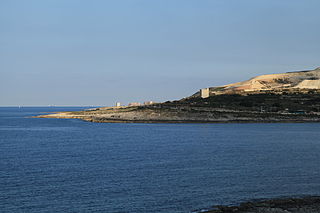
The De Redin Towers are a series of small coastal watchtowers built in Malta by the Order of Saint John between 1658 and 1659. Thirteen towers were built around the coast of mainland Malta to act as watchtowers. Eight of the towers still survive.
The Lascaris Towers are a series of mostly small coastal watchtowers built in Malta by the Order of Saint John between 1637 and 1652. The first seven towers were built around the coast of mainland Malta between 1637 and 1638. Between 1647 and 1652, a large tower was also built on mainland Malta, and two smaller ones were built on Gozo.
The Wignacourt towers are a series of large coastal watchtowers built in Malta by the Order of Saint John between 1610 and 1620. A total of six towers of this type were constructed, four of which survive.

Din l-Art Ħelwa is a non-governmental and non-profit, voluntary organisation founded in 1965 by Maltese Judge Maurice Caruana Curran to safeguard Malta's cultural heritage and natural environment. Since its foundation, Din l-Art Ħelwa has restored numerous cultural sites of historic and environmental importance and currently has the guardianship of a number of them. Many of the sites are open to visitors and for events, all thanks to an army of dedicated volunteers. The organisation promotes the preservation and protection of historic buildings and monuments, the character of Malta's towns and villages, and places of natural beauty. It is very active in campaigning against proposed construction which infringes planning laws or policies, and regularly objects to planning applications, taking legal action to halt development in some cases. The NGO stimulates the enforcement of existing laws and the enactment of new ones for the protection of Malta's natural and built heritage.

Saint Mary's Tower, also known as the Comino Tower, is a large bastioned watchtower on the island of Comino in Malta. It was built in 1618, the fifth of six Wignacourt towers. The tower was used by the Armed Forces of Malta until 2002, and it is now in the hands of Din l-Art Ħelwa.

Xlendi Tower is a small watchtower near Xlendi Bay, within the limits of Munxar on the island of Gozo in Malta. The tower is one of the Lascaris towers and dates to 1650; it is currently undergoing restoration.

Lascaris Battery, also known as Fort Lascaris or Lascaris Bastion, is an artillery battery located on the east side of Valletta, Malta. The battery was built by the British in 1854, and it is connected to the earlier St. Peter & Paul Bastion of the Valletta Land Front. In World War II, the Lascaris War Rooms were dug close to the battery, and they served as Britain's secret headquarters for the defence of the island.
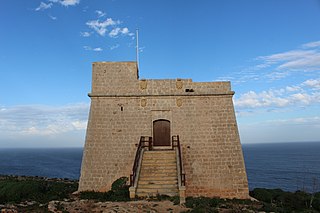
Sopu Tower, also known as Isopu Tower, San Blas Tower or Torre Nuova, is a small watchtower situated on the cliff between San Blas and Daħlet Qorrot in Nadur, Gozo, Malta.

Sciuta Tower, also known as Sciutu Tower or Wied iż-Żurrieq Tower, is a small watchtower in Qrendi, Malta. It was completed in 1638 as the fifth of the Lascaris towers. The tower was restored by Din l-Art Ħelwa.
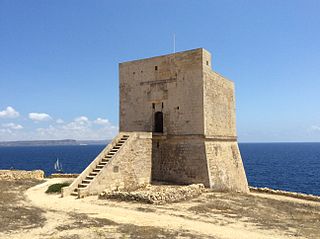
Mġarr ix-Xini Tower is the largest of the coastal watchtowers that the Knights of Malta erected on the island of Gozo. It watches over the entrance to the bay of Mġarr ix-Xini, limits of Għajnsielem, which lies on Gozo's south-west coast.

The fortifications of Malta consist of a number of walled cities, citadels, forts, towers, batteries, redoubts, entrenchments and pillboxes. The fortifications were built over hundreds of years, from around 1450 BC to the mid-20th century, and they are a result of the Maltese islands' strategic position and natural harbours, which have made them very desirable for various powers.
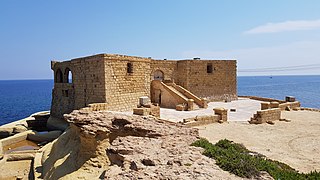
Qolla l-Bajda Battery is an artillery battery in Żebbuġ, Gozo, Malta. It was built by the Order of Saint John between 1715 and 1716 as one of a series of coastal fortifications around the coasts of the Maltese Islands. It retained its original layout until the late 1970s, when it was converted into a discothèque and snack bar known as Rook and major alterations were made to the battery. The building is now abandoned and in a dilapidated state, being in the midst of a legal battle between the government and a private company.
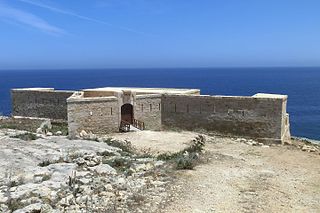
Saint Anthony's Battery is an artillery battery in Qala, Gozo, Malta. It was built by the Order of Saint John between 1731 and 1732 as one of a series of coastal fortifications around the coasts of the Maltese Islands. It is one of only two surviving batteries on Gozo, the other one being Qolla l-Bajda Battery in Żebbuġ.
Saint Mary's Battery, also known as Qolla s-Safra Battery or Gironda Battery, was an artillery battery in Marsalforn, limits of Żebbuġ, Gozo, Malta. It was built by the Order of Saint John in 1715 as one of a series of coastal fortifications around the Maltese Islands.
From RAF Operations Record Book RAF 1435 Squadron (National Archives, UK Ref AIR 27/2342)


















